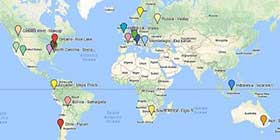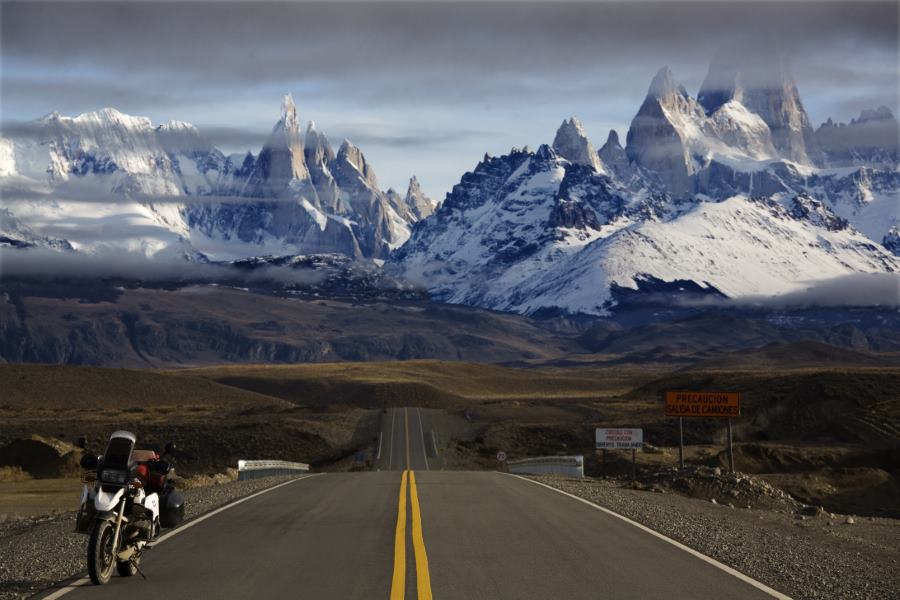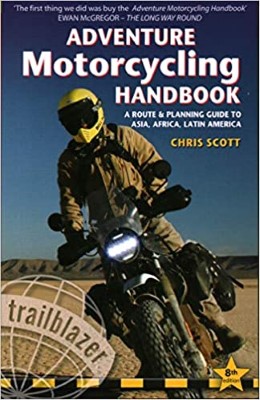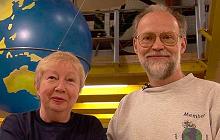Our goal for today was the Tad Lo waterfall on the Bolaven Plateau. However, this destination and many of the roads in the area are not covered by the maps in my GPS. We also have a not very detailed map of Laos, Vietnam, and Cambodia, which also does not show our destination. So today, we'll be relying on the tiny map in the Lonely Planet and some vague descriptions we found online. As near as we could figure, we would head south on Highway 13 to Koang Sedon, and then turn east on Highway 15, which should eventually intersect with Highway 20, where we would head back west and south a short distance to Tad Lo. Unlike Thailand, the roads in Laos are generally not very well signed, so navigating today could prove to be exciting.
Having no idea how long it would take to reach our destination, we got up early, had watermelon and a baguette sandwich, and hit the road by 8:30 am. It was already warm and somewhat humid when we began riding and it steadily got hotter. Again, the ride down Highway 13 was great, flat, dusty, and boring, just muddy rivers and scrubby trees. A quick check of the thermometer showed that it was already in the high 90s before noon. We decided that looking at the thermometer was only making us feel hotter, so we put it away for good. We spied signs for Kongxedone and decided it was close enough to be Koang Sedon. In Kongxedone, there was a sign pointing west that said “Salavan.” Salavan was at the end of Highway 15, so this must be our road.

Except that when we turned onto it, it was dirt. At first it was hard-packed and smooth, but then it varied between this and being covered with two inches of powdery dirt and potholed dirt.

We were on this road for about 50 miles, and it appeared in some areas that they are planning to pave it sometime, but not today. At many of the river crossings, the bridges were under construction, so we had to detour down to river level and cross the riverbed. Fortunately, it is the dry season, so we only ran into a couple patches of mud. The riding was very challenging on our little bikes, but I was happy to see Re safely making her way through the deep silt, since I know that, after Namibia, these kinds of conditions make her nervous. At one point, we had to take a detour from our dirt road to another, smaller, dirt road that passed through a couple of tiny villages. The road here ran along a small canal, in which there were several groups of naked five- to ten-year olds, frolicking in the water. If we had known at the time that Tad Lo was only another hour away, I would have stopped and jumped in with them. Did I mention, it was hot?
Shortly after the detour, my GPS, which had up until now not shown a single road in the area, suddenly displayed Highway 20 about 6 miles south of the road we were on. A mile or so later, I spied a single-lane dirt road heading south out of a small village. I hoped that it would go all the way through to Highway 20, so we followed it south as it wound its way, eventually, to Highway 20! This single-lane road was an even more challenging road than Highway 15, but I am glad to report that both of us made it through safe and sound. We were overjoyed to see that Highway 20 was paved, and doubly happy to see a sign that said Tad Lo 25 km. We headed east again, and the 35- to 40-mph that we were able to maintain made for much better airflow through our jackets. We followed the signs into Tad Lo and were soon greeted by a very scary bridge and beautiful waterfall. One surprising thing about this town is the number of farang on little underbones. Apparently the guesthouses in Pakse are now promoting a 3- to 4-day DIY riding loop around the Bolaven Plateau. It's kind of cool, but it also made Re and I cringe a little, since most people's protective riding gear consisted of flipflops, silk pants, and dreadlocks.
While there were guesthouses before the bridge, we decided to cross it to be closer to the waterfall, and that's when disaster nearly struck.

Many boards that make up the deck of the bridge have rotted or are missing. As I was trying to avoid an area of particularly bad boards, I swerved and came within millimeters of hitting the side of the bridge. But somehow, I managed to avoid it. Not skill, just dumb, ****in' luck. While Re went to scout out some accommodations, I pulled into the shade of a tree, turned off the bike, and my hands were shaking when I removed them from the handlebars.
Re found us a nice bungalow near the waterfall, so we unpacked our bikes, schlepped our gear up the long, uneven path, stripped off our Dariens, and jumped into the shower to wash off the thick layer of red dust. Since we had no lunch today, we decided to head out for an early dinner. Most of the restaurants were on the other side of the bridge, and when we walked across, we could see what poor shape it was actually in. We found a really cheap place for dinner called Mama Paps, where Re had chicken larp and I had spicy pork and sticky rice. We also each had a fruit shake and split a big Beer Lao, and our total bill was 7.50 USD, and we were stuffed. Mama Paps sign says “Big food for small kips,” and it's true. Now that the sun was truly down, the bridge was even scarier going back in the dark. Fortunately, Re had her headlamp in her daypack. We were both exhausted after today's ride, so we were in bed with lights out at 9:00 pm. Damn, we're getting old!
185 miles in 7.5 hours. Between the dirt roads, dust, and heat, this is what we imagined riding in Africa would be like. For the record, the vast majority of the roads we traveled in Africa were paved.

















 5Likes
5Likes













 Threaded Mode
Threaded Mode







